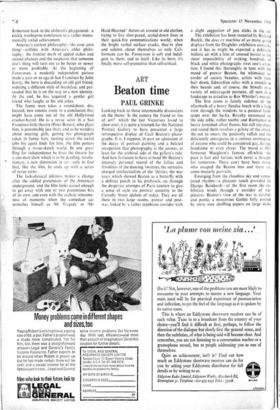Beaton time
ART PAUL GRINKE
Looking back to those interminable discussions on the theme 'Is the camera the friend or foe of art?' which the late Victorians loved to chew over, it is quite a triumph for the National Portrait Gallery to have presented a large retrospective display of Cecil Beaton's photo- graphs. It is, I suppose, in part an admission of the decay of portrait painting and a belated recognition that photography is the answer, at least for the archival side of the gallery's role. And how fortunate to have at hand Mr Beaton's intensely personal record of the follies and frivolities of the dancing 'twenties, the surrealist charged intellectualism of the 'thirties, the war years which showed Beaton as a butterfly with a definite punch in his proboscis, on through the desperate attempts of Paris couture to give a sense of style via postwar austerity to the Carnaby Street idolum of today. They are all there in two large rooms, prewar and post- war, linked by a rather tenebrous corridor with a slight suggestion of joss sticks in the air.
The exhibition has been mounted by Richard Buckle, the dens ex machina of so many grand displays from the Diaghilev exhibition onwards, and it has as might be expected a definitely balletic air with a hint of amused horror at the sheer impossibility of making hundreds of black and white photographs rivet one's atten- tion. I found this thoroughly in tune with the mood of prewar Beaton, the whimsical re- corder of society beauties, artists with their hair down, Edwardian relics with a twinkle in their beards and, of course, the Sitwells in a variety of extravagant postures, all seen in a landscape as arcadian as Rex Whistler's murals.
The first room is faintly redolent of the aftermath of a heavy Sunday lunch with a long view through the windows to a pastoral land- scape over the ha-ha. Royalty ensconced on the side table, rather toothy and Ruritanian in heavy tarnished silver frames but still top dogs, and round them revolves a galaxy of the smart, the not so smart-, the positively raffish and the deliciously outrageous in a curious cosmogony of anyone who could be considered gay, daring, handsome or even clever. The mood is Mrs Somerset Maugham's famous off-white, the pace is fast and furious with never a thought for tomorrow. There can't have been many who escaped the Beaton lens and there are some masterly portraits.
Emerging from the cloudless sky 'and synco- pated rhythm—a pleasant touch provided by Django Reinhardt—of the first room the ex- hibition winds through a corridor of war pictures. Beaton's view of the war is cavalier and poetic, a monstrous Gothic folly erected by stern men shuffling papers, on large desks and inhabited by groups of cheerful men un- conscious of the sword over their heads. The second, postwar room, arranged as a studio with a splendid large revolving postcard stand shows Beaton in all his diversity. Dewy Hollywood stars pouting at the camera, a marvellous group of studies of Garbo and Marilyn Monroe, the famous and the not so famous from all walks of life right up to yester- day, with one or, two familiar faces from tomorrow. The exhibition deserves to be a roaring success and one might hope finds a per- manent home in the gallery. Be warned, inci- dentally, that the immaculate Mr Beaton, stand- ing with flashlight and poised camera at the exit, is, alas, only a poor thing of cardboard and celluloid.







































 Previous page
Previous page